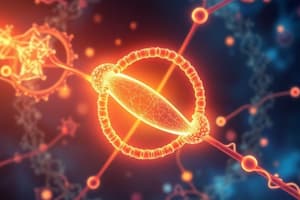Podcast
Questions and Answers
What is the primary function of ATP in cellular processes?
What is the primary function of ATP in cellular processes?
- To provide energy for cellular activities (correct)
- To act as a structural component of cell membranes
- To facilitate the transport of molecules across cell membranes
- To store genetic information
Which process directly produces ATP in the mitochondria?
Which process directly produces ATP in the mitochondria?
- Glycolysis
- Fermentation
- Photosynthesis
- Electron transport chain (correct)
What type of energy transformation occurs during cellular respiration?
What type of energy transformation occurs during cellular respiration?
- Chemical energy to mechanical energy
- Chemical energy to kinetic energy
- Chemical energy to ATP energy (correct)
- Solar energy to chemical energy
Which metabolic pathway requires oxygen to generate energy?
Which metabolic pathway requires oxygen to generate energy?
During photosynthesis, what is the main source of energy for the conversion of carbon dioxide and water into glucose?
During photosynthesis, what is the main source of energy for the conversion of carbon dioxide and water into glucose?
Flashcards
Cellular Respiration
Cellular Respiration
A process where cells break down glucose to release energy.
ATP
ATP
The main energy currency of the cell.
Glucose
Glucose
A sugar that provides energy for the cell.
Mitochondria
Mitochondria
Signup and view all the flashcards
Photosynthesis
Photosynthesis
Signup and view all the flashcards
Study Notes
ATP Structure
- ATP stands for adenosine triphosphate.
- It's a nucleotide that stores chemical energy in its high-energy phosphate bonds.
- ATP is composed of an adenine base, a ribose sugar, and three phosphate groups.
- The bonds between phosphate groups are unstable, making ATP a high-energy molecule.
ATP Hydrolysis
- ATP hydrolysis is the process of breaking down ATP into ADP (adenosine diphosphate) and inorganic phosphate (Pi).
- This reaction releases energy, which is used by cells for various processes such as muscle contraction, active transport, and protein synthesis.
- The reaction is exergonic (releases energy).
- The reaction is catalyzed by enzymes such as ATPase.
ATP Synthesis
- ATP is synthesized through cellular respiration.
- Cellular respiration occurs in the mitochondria, which are the powerhouses of the cell.
- Two main processes contribute significantly to ATP synthesis are:
- Glycolysis
- Oxidative Phosphorylation (electron transport chain)
Cellular Respiration
- Cellular respiration is the process by which cells break down glucose to release energy.
- This energy is then used to produce ATP.
- Cellular respiration has three main stages:
- Glycolysis
- Krebs Cycle
- Electron Transport Chain
Glycolysis
- Glycolysis is the first stage of cellular respiration.
- It occurs in the cytoplasm of the cell.
- In glycolysis, glucose is broken down into two molecules of pyruvate.
- A small amount of ATP is produced during glycolysis.
Krebs Cycle
- The Krebs Cycle (also known as the Citric Acid Cycle) is the second stage of cellular respiration.
- It takes place in the mitochondrial matrix.
- During the Krebs Cycle, pyruvate is further broken down, releasing carbon dioxide and producing more energy-carrying molecules (NADH and FADH2).
Electron Transport Chain
- The electron transport chain is the third stage of cellular respiration.
- It occurs in the inner mitochondrial membrane.
- Electrons from NADH and FADH2 are passed along a series of protein complexes, releasing energy.
- This energy is used to pump protons (H+) across the membrane, creating a proton gradient.
- The flow of protons back across the membrane through ATP synthase drives the synthesis of ATP in a process called chemiosmosis.
ATP as an Energy Carrier
- ATP acts as a key energy carrier in the cell.
- It delivers energy to various cellular processes that need energy to function.
- ATP is constantly being used and regenerated, enabling cells to maintain efficient energy production.
- Examples of cellular processes ATP powers:
- Muscle contraction
- Active transport
- Protein synthesis
- Cell division
- Nerve impulse transmission
Other Energy Carriers
- NADH and FADH2 are crucial electron carriers in cellular respiration.
- They accept high-energy electrons during glycolysis and the Krebs cycle, transferring them to the electron transport chain.
Anaerobic Respiration
- Some organisms can produce ATP without oxygen.
- This process is called anaerobic respiration.
- An example of anaerobic respiration is fermentation.
- During fermentation, pyruvate is converted to other molecules such as lactic acid or ethanol, enabling the regeneration of NAD+ to allow glycolysis to continue.
Fermentation
- Fermentation is a type of anaerobic respiration.
- It occurs in the absence of oxygen.
- It involves the incomplete oxidation of glucose.
- Two common types of fermentation:
- Lactic acid fermentation (e.g muscle cells during strenuous exercise)
- Alcoholic fermentation (e.g yeast)
- Fermentation yields less ATP than cellular respiration.
Comparison of Aerobic and Anaerobic Respiration
- Aerobic respiration requires oxygen and produces significantly more ATP than anaerobic respiration.
- Anaerobic respiration does not require oxygen, but produces less ATP.
- Cellular Respiration occurs fully in the presence of oxygen(Aerobic).
- Fermentation is a type of anaerobic respiration.
Cellular Location
- Glycolysis takes place in the cytoplasm.
- Krebs cycle (citric acid cycle) and the electron transport chain take place in the mitochondria.
Studying That Suits You
Use AI to generate personalized quizzes and flashcards to suit your learning preferences.



